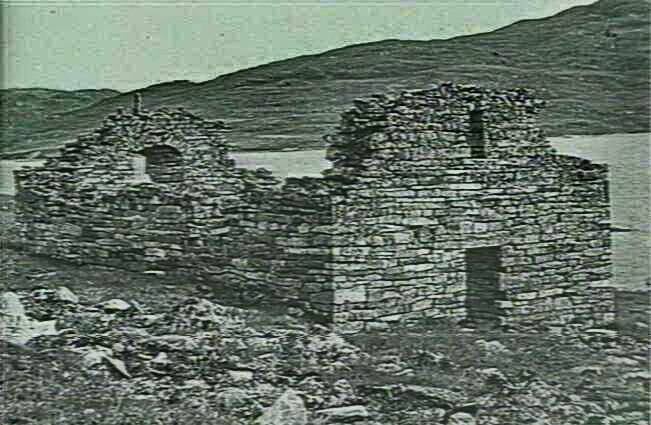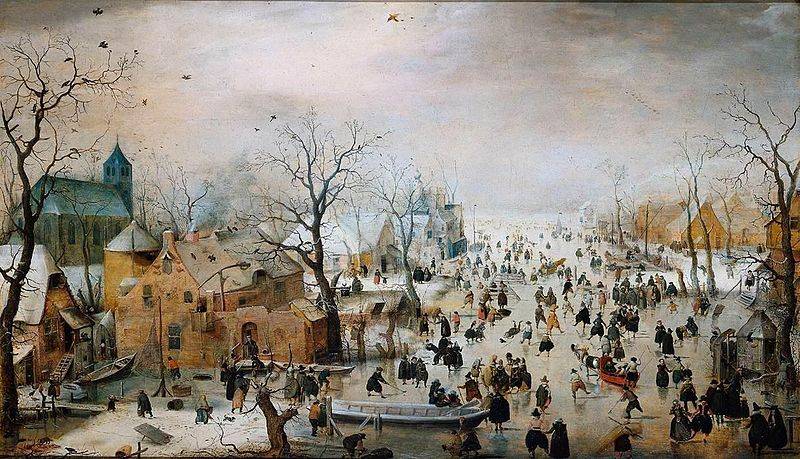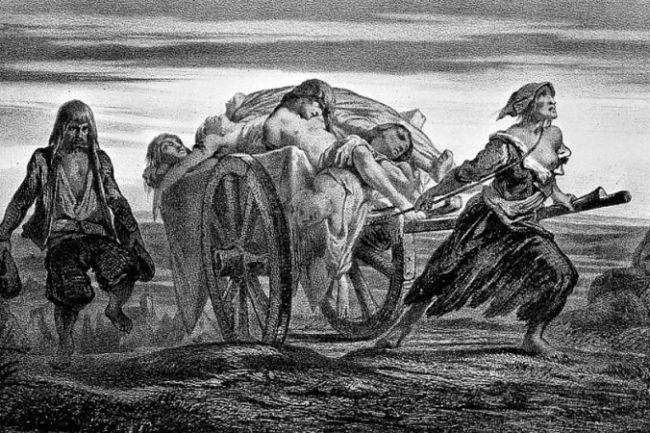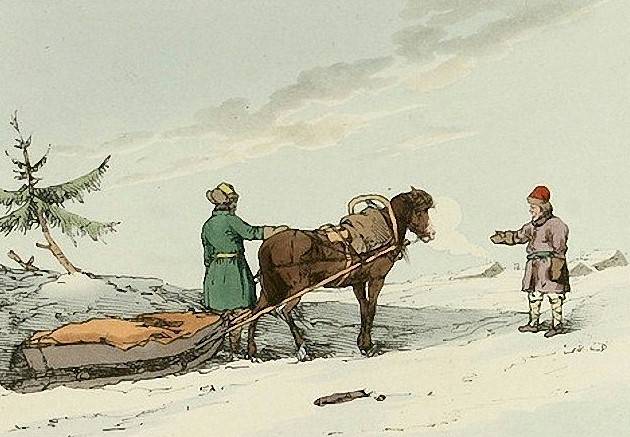Cold and hunger. How Russia suffered the Little Ice Age
The 1601 famine of the year was one of the links in the chain of terrible and not very consequences of the Little Ice Age. As is known, the so-called period of large-scale and very strong cooling in the XIV-XIX centuries. At this time, the climate of Europe changed for the worse, colder side, which could not but affect agriculture, the state of communications and, in general, the social life of European states. Russia was not an exception in the list of European countries affected by the global cooling.
Now researchers agree that the main reason for the onset of the Little Ice Age in Europe was the slowdown of the Gulf Stream, which occurred around the year 1300. After that, the climate in Western Europe began to seriously change for the worse. At first, it became seriously colder even in the summer, a large amount of precipitation began to fall, which led to the death of the crops in 1312-1315. Permanent rains and cold weather caused serious damage to European agriculture, especially in the northern regions of Western Europe. If before, even in Northern Germany and Scotland there were vineyards, then after cold years, viticulture in these regions ceased. After the cooling of those years, viticulture forever remained the prerogative of the inhabitants of only Southern Europe - Italy, Spain, Portugal, France, Greece. Snow fell in Italy, which used to be extremely rare, to which the Italian peasants, who were accustomed to heat, were not ready.

Cooling led to famine in Western Europe, which, in turn, caused a series of peasant uprisings against the feudal lords. The economic situation in European countries was rapidly deteriorating, which led to a number of negative consequences. Thus, the onset of glaciers in Greenland led to the practical disappearance of cattle breeding and agriculture on the island. The once flourishing Norwegian colony began to rapidly empty, which was promoted not only by the crisis of Greenland agriculture, but also by the difficulty of communication with the mainland. In 1378, the Greenland Bishopric in Gardar was abolished, and by the 16th century, European settlements in Greenland finally ceased to exist. Travelers who arrived on the island in the 18th century found only Eskimos here.
The offensive of the Little Ice Age affected Russia somewhat later than the European countries. The most difficult for the Russian land turned out to be the XVI century. Cooling struck the Russian agriculture no less than in Europe, which led to a general deterioration in the quality of life of the population. If before European travelers wrote about the relative prosperity of the Russian peasants, then because of the cold snap, the situation began to change. Within only one century, grain prices in Russia grew eight times. Crop failure and rising food prices led to a protracted economic crisis, followed by a demographic decline in the conditions of that time. In other words, many villages simply died of starvation. Sources indicate mass mortality in 1540-e - 1560-e. In search of a better life, people rushed from the starving and cold regions of Central Russia to the south and southeast. The most serious blow was dealt to the economy and demography of the north-western regions of Russia. Here, the cooling was manifested most clearly and created serious obstacles to agriculture. In the period between 1500-1550. The population of the North-Western Russian lands decreased by about 15%. The situation in Veliky Novgorod deteriorated very much, then in Moscow lands. The loss of population reached in the north-west and in the center of the Russian state of catastrophic proportions.

Simultaneously with the demographic decline in the north and in the center of Russia, there was a general increase in the number of Cossacks. It is the XVI - XVII centuries. became a period of maximum growth in the number of Cossacks - not only on the Don, but also on the Volga and Yaik. Many inhabitants of the central Russian lands fled to the Cossack lands and joined the Cossacks. After all, the climate in the southern regions was still more favorable, and the Cossack lifestyle itself provided more opportunities for food. In the Polish – Lithuanian Commonwealth, which also experienced the effects of the Little Ice Age, similar processes began. Many residents of more northern regions of the Commonwealth, above all - the Grand Duchy of Lithuania, were in a hurry to move to the south, in Zaporizhzhya lands, replenishing the ranks of Zaporizhzhya Cossacks.
At the same time, crime has increased in the vast expanses of Muscovy and in the Wild Steppe. Those who fled from hunger and cold to the south, many residents of the Russian lands, in the absence of any other means of obtaining livelihoods, became robbers. The incredible increase in the number of robbers during this period was reported by many European and Eastern travelers.
At the same time, during this period, the number of Slav slaves in the slave markets of the Crimean Khanate increased, reaching its historic maximum. This was due to two reasons. First, the Crimean Khans immediately took advantage of the desertion of many villages in Central Russia and began to raid hard, leading Russian peasants to the full, and secondly, many peasants who tried to move to the south themselves fell into the hands of slave traders. The same can be said about the immigrants from the Commonwealth. By the way, in the slave markets of the Crimea people from the Polish-Lithuanian lands were valued higher than the former subjects of the Moscow tsar because of the obstinate temper of the latter.
In 1571, the troops of the Crimean khan Devlet-Girei laid siege to Moscow. The campaign was undertaken by the Crimean Khan with a very specific task - to rob the Russian capital and capture as many people as possible for the subsequent sale into slavery in the slave markets of the Crimea. Crimean troops 3 June went to the outskirts of Moscow and ravaged settlements and villages, and then set them on fire. The Zemsky army, instead of fighting with the Crimean horde, began a disorderly retreat, while Prince Belsky, who commanded the voivode, was killed. A terrible fire began, which in three hours destroyed the whole wooden Moscow. On the siege of the Kremlin, Khan, however, did not go and retired from the capital towards the steppe, taking with him up to 150 thousands of prisoners - men, women, and children.

Hunger and the Crimean campaigns were only part of the terrible misfortunes that hit Russia after the cooling. After 1570 turned out to be a poor year, and people were ready to kill each other for food, the plague epidemic began in 1571. In Europe, the worst plague epidemic, nicknamed the “Black Death”, took place two centuries earlier - just when Europe faced a massive cooling. In 1346, a plague was brought from Central Asia to the Crimea and then penetrated into Europe. Already in 1348, the plague victims were 15 million people, which was at least a quarter of the then European population. By 1352, the number of plague victims in Europe reached 25 million people, which was then one third of the population.
The plague epidemic in the Moscow kingdom in 1571, of course, was not as ambitious as the "black death" that swept Europe in the XIV century. However, many people died from the disease. The corpses were buried even without coffins, in mass graves, so large was the number of people who died from this terrible disease. It was famine and plague, and not the “atrocities of the guardsmen”, that caused the devastation of the Russian lands in the 1570s.
Even more terrible famine was waiting for Russia in three decades. 19 February 1600 in far Peru, the existence of which the overwhelming majority of the inhabitants of Russia did not even know then, erupted on the volcano Uaynaputina. As a result of the eruption, which has become the most ambitious event of its kind in stories South America, killed about a thousand people. But in addition to human casualties among Peruvian Indians, the eruption of the volcano led to large-scale climate change in the direction of further cooling. Europe, and then Russia, was swept by torrential rains that lasted ten weeks. In fact, the Russian lands were left without a crop, which caused hunger among the population.
Hunger quickly took on the features of a national catastrophe. In Moscow alone, at least 127 thousands of people died of starvation within two years. Landowners quickly invented an effective way to fight hunger in their possessions — they simply let their serf peasants freely or simply drove them “to free bread” so as not to feed them. In turn, starving peasant families died out en masse. Young and strong men were looking for another way to soak themselves - huddled in robber gangs, engaging in robbery on major roads. Gangs could include dozens and even hundreds of robbers, which made fighting them a big problem for the Moscow authorities. Some travelers reported cases of cannibalism in villages where people literally went crazy with hunger.
On the other hand, the clergy and landowners, who owned huge stocks of bread, significantly increased their fortunes by engaging in speculative trade in bread. Tsar Boris Godunov was unable to control the situation and, at least, to achieve the sale of bread not at speculative prices. All this together led to a sharp surge of popular discontent, numerous uprisings, the largest of which was the Cotton uprising. Then an impressive army moved to Moscow, assembled by the False Dmitry I. The political situation in the country rapidly destabilized. 13 (23) April 1605, at the most inopportune moment, died king Boris Godunov. Began one of the most tragic pages in Russian history - Time of Troubles.
Great Famine 1601-1603 led to serious consequences for the political and social development of the Russian state. If politically, famine was followed by the Time of Troubles, the Polish invasion, the Russian-Swedish war, numerous peasant uprisings and the establishment of the Romanov dynasty, then socially the Great Famine contributed to the settlement of the formerly sparsely populated margins of the country - the lands on the Don, Volga and Yaik. The number of Cossacks in this period increased even more.
The Little Ice Age significantly changed the climatic conditions in the Russian state. The winters became longer, the summer shorter, the yield decreased, which could not but affect the general living conditions of the population. Half a century after the Great Famine of 1601-1603, during the next Russian-Polish war, Polish forces could hardly endure the harsh months of the winter of 1656. During the campaign only from frost killed before the 2000 Polish soldiers and about a thousand horses. At the same time, Polish troops suffered such losses only in the southern regions of the Russian state. So the cold became one of the main "allies" of Russia, to which help the country resorted then repeatedly.

Russia experienced a new cooling wave in the middle - second half of the 18th century. The consequences this time were less devastating than in the XVI-XVII centuries. Nevertheless, the next phase of the Little Ice Age contributed to a further cooling. Travelers who were at this time in Siberia, noted very severe frosts, a long duration of winter. So, Johann Falk, a Swedish traveler who visited Siberian lands in 1771, observed snow blizzards in May and September. By this time, Russia had long had the image of a very cold country, although before the onset of the Little Ice Age, travelers did not particularly focus on the peculiarities of Russian climatic conditions. The well-known "wintering" of the French troops of Napoleon in Russia also became a real test for European soldiers precisely because of the deterioration of the climate after the onset of the Little Ice Age.
Many researchers note, however, and the presence of positive effects of the small ice age. For example, Margaret Anderson associated with them a large-scale settlement of the New World. People traveled to South and North America in search of a better life, as it was becoming more and more difficult to live in Europe. Due to cooling there was a much greater need for heat sources, which led to the development of coal mining in European countries. For coal mining, industrial enterprises were created, a class of professional workers — coal miners — was formed. That is, the cooling has contributed to the scientific, technical and economic revolution in Europe at the junction of the late Middle Ages and the New Age.
Information